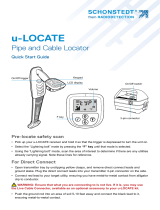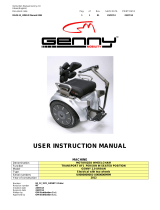Page is loading ...

Locating with the C.A.T and Genny
The Genny is used to apply a tone to a buried
conductor. This signal can be traced using the C.A.T
locator switched to the Genny mode.
Direct Connection
Direct Connection is the most effective form of signal
application and is suitable for connection to a valve,
meter, junction box or other access point.
WARNING
Connection to a power cable sheath should only
be undertaken by qualified personnel.
Method
Plug the Connection lead into the Genny connection
socket and attach the red lead to the target line. If
necessary clean the connection point to ensure a good
electrical contact.
Clip the ground lead to the earth stake which should
be placed in the ground 3 to 4 paces away from, and
at right angles to the target line.
Alternatively the ground lead may be clipped to the rim
of a valve box or manhole cover. Use the spool lead to
extend the earth connection if necessary.
Switch the Genny on. A good connection is indicated
by a drop in loudspeaker tone. If there is no tone or it
is a very slow bleep, replace the batteries.
Switch the C.A.T to Genny mode and begin to trace
the line from the point of application. Pinpoint using the
same method as described for Power and Radio
modes.
Sweep holding the C.A.T upright and at your side.
Contunue the sweep beyond the perimeter of the area
to be excavated.
The presence of a buried conducting pipe or cable will
be indicated by a tone emitted from the loudspeaker.
Keep the blade of the C.A.T vertical and move slowly
backwards and forwards over the conductor, reducing
the sensitivity for a narrower response. With the
C.A.T+ use the meter deflection to aid pinpointing.
Maximum meter deflection
will indicate the position of
the conductor.
When directly over the
conductor and with the
sensitivity level set for a
narrow response, rotate
the C.A.T on its axis until
the signal minimum is
found. The blade is now in
line with the conductor.
Trace the conductor out of
the area, marking the
position as required with chalk or paint.
Radio mode
For detection of radio signals originating from distant
radio transmitters. These penetrate the ground and are
re-radiated by buried conductors. However, they are
not always present.
After completion of Power mode sweep, repeat the
procedure with Radio mode selected.
WARNING
The C.A.T will detect almost all buried conductors
but there are some which do not radiate any signal
which the C.A.T will not detect.
There are also some live power cables which the
C.A.T is not able to detect in the Power mode.
The C.A.T does not indicate whether a signal is
from a single cable or from several in close
proximity.
Note
The C.A.T+ will not provide depth information in either
the Power or Radio modes.
C.A.T+ Locator features
The basic features of the C.A.T+ are the same as the
C.A.T but with the addition of a liquid crystal display.
1 Signal strength
2 Mode indicator
3 Depth
4 Depth button
Genny+ Transmitter features
The only differences between the Genny and Genny+
are that the signal radiating from the Genny+ and the
tone from its speaker are continuous rather than
pulsed. Operationally they are similar.
Operation of Power and Radio modes
Regularly check your C.A.T and Genny, in all
modes, over a cable which gives a response you
are familiar with.
Power mode
For detection of ‘power’ signals radiated by loaded
cables. These are often found ‘re-radiated’ by other,
nearby conductors. Select Power using the Function
switch. Press and hold the On/Off switch. Replace
batteries if no initial ‘bleep’ is heard to confirm good
battery condition.
Rotate the Sensitivity
Control fully clockwise
for maximum
sensitivity but reduce
if there is a blanket
signal across the site.
Define the area to be
excavated and carry
out a grid pattern
sweep.
C.A.T Locator features
1 On/Off
Press and hold to use C.A.T
2 Loudspeaker
Detachable speaker for use in
noisy environment.
3 Sensitivity control
4 Function switch
Selects locate mode:
Power, Radio, Genny.
5 Battery compartment
To replace batteries, open the
access cover using a
screwdriver or coin. Use eight
LR6 or AA alkaline batteries.
WARNING
When using the C.A.T in noisy environments, the
speaker can be detached and held closer to the ear.
To avoid excessive noise exposure it is advisable
to hold the speaker no closer than 15cm (6”) from
the ear. Prolonged use at this level should be
avoided.
Genny Transmitter
features
1 On/Off button
Press and hold to reduce
speaker volume.
2 Direct Connection socket
3 Loudspeaker
4 Battery compartment
To replace batteries, open
the access cover using a
screwdriver or coin. Use
four LR20 or D alkaline
batteries.
5 Storage compartment
holding Connection Cable,
Ground Stake and Ground
Cable.
User guide
for C.A.T and Genny
and C.A.T+ and Genny+
The C.A.T and Genny combine to make
the perfect general purpose tools for cable
avoidance. Their rugged construction
ensures long life and reliability whilst the
simple controls promote effective use with
minimal training.
For those who require pinpoint accuracy
and depth information, the C.A.T+ and
Genny+ add visual indication of signal
strength together with a buried utility depth
measurement capability.
5
3
4
1
2
5
2
1
3
4
m
Depth
Mode/clockface
Signal
strength
Depth
button
www.radiodetection.com

Using the optional Mouse Signal Transmitter
The Mouse is a small self-contained watertight
transmittter which can be detected by the C.A.T when
switched to the Genny mode.
Method
Replace the battery in the Mouse. Attach the Mouse to
a drain rod using an appropriate connector (purchased
separately).
Place the Mouse on the ground, set the C.A.T to
Genny mode and, whilst holding the C.A.T in line with
the Mouse, check that a signal is being received.
Insert the Mouse approximately 1m/yd into the
duct/drain and adjust the C.A.T sensitivity to receive
the signal.
A ghost signal appears before and behind the main
signal position. Reduce the C.A.T sensitivity to receive
only the main signal.
Using the optional Signal Clamp
The Signal Clamp applies a Genny signal safely to a
pipe or live cable of up to 76mm (3 inches) diameter,
without interrupting the supply.
Method
Plug the Clamp into the Genny Connection socket.
Place the Clamp around the pipe or cable ensuring the
jaws are closed. Switch the Genny on. Open and close
the Clamp. If the jaws are closing correctly a drop in
speaker tone will be heard.
An earth
connection is not
necessary but
efficient signal
transfer is only
achieved if the
target conductor is
grounded at both
ends. This is
usually the case
with power cables.
The Signal Clamp can be used with either Genny or
Genny+
Using the optional Live Plug Connector
The Live Plug Connector applies the Genny signal to a
live domestic power socket and, via the domestic
wiring system, to the service cable and supply cable in
the street.
Method
Connect the Live
Plug Connector to
the Genny socket
and the power
socket.
Switch on the
power socket and
the Genny.
Note
The Live Plug
Connector provides
protection to 250Vac.
Induction
Induction is a convenient and quick way of applying the
Genny signal to a pipe or cable where limited access
does not permit direct connection or use of the Signal
Clamp.
Place the
Genny over the
assumed
position of the
conductor in the
orientation
shown.
Start tracing the cable or pipe at least five paces from
the Genny with the C.A.T in Genny mode. Working too
close to the Genny may give false readings as the
C.A.T will detect more signal directly from the Genny
than from the conductor.
If using the C.A.T+ do not attempt to take depth
readings unless the distance between the C.A.T+ and
Genny+ is greater than 30 paces (see ‘Taking depth
readings using the C.A.T+’).
Active search
using
Induction
Placing the
Genny on its
side swamps
an area with
Genny signal.
Alternatively,
use a two
man
technique to
search an
area for
buried utilities.
Taking line depth measurement using the C.A.T+
Depth measurement is only possible when using the
C.A.T+ in the Genny mode with a Genny+ transmitter.
Method
Locate the utility as
described previously.
Ensure that the
depth measurement
position is at least
30 paces from the
Genny, especially if
signal application is
by Induction method.
Hold the C.A.T still,
vertical and at right angles to the buried line. Momentarily
depress the depth button. The display will show a moving
clockface followed by the depth measurement.
Taking Mouse depth measurements using the C.A.T+
Depth measurement is only possible when using the
C.A.T+ in the Genny mode with a Mouse+ transmitter,
identified with a central orange band.
Method
Locate the main Mouse signal as previously described.
Hold the C.A.T vertically and
in line
with the Mouse.
Press
and hold
the depth button until ‘M’ appears on the
display. A clockface will appear in the top right hand
corner of the display while the depth calculation is made.
The approximate depth to the Mouse will then be
displayed on the meter.
C.A.T+ error codes
indicates very shallow conductor
indicates conductor out of range
indicates depth measurement attempted in
R or P mode which is not available.
WARNING
Do not use the C.A.T+ depth measurement to decide
if mechanical digging over buried conductor is
appropriate.
Peak
Ghost Ghost
d
d
min 30 paces
recommended
90/NUG01ENG/1 2.01
Radiodetection Ltd, Western Drive, Bristol, BS14 0AZ, United Kingdom
Tel
+44 (0)117 9767776 Fax +44 (0)117 9767775 [email protected]
Radiodetection Corp, 35 Whitney Road, Mahwah, NJ 07430, USA
Tel
+1 (201) 848-8070 Fax +1 (201) 848-1303 [email protected]
Radiodetection GmbH, Rauhe Straße 18, D-46459 Rees, Germany
Tel
+49 (0)2851-9237-20 Fax +49 (0)2851-9237-520
[email protected] http: //www.radiodetection.de
Radiodetection Sarl, 13 Grand Rue, 76220 Neuf Marché, France
Tel
+33 (0)2 32 89 93 60 Fax +33 (0)2 35 90 95 58 [email protected]
Radiodetection S.r.l, Via XX Settembre 43, 27020 Gravellona Lom (PV), Italy
Tel
+39 0381 959811 Fax +39 0381 95884 [email protected]
Radiodetection B.V. Benelux, Industriestraat 11, 7041 GD 's-Heerenberg, Netherlands
Tel
+31 (0)314 66 47 00 Fax +31 (0)314 66 41 30 [email protected]
Radiodetection (Canada) Ltd, 344 Edgeley Blvd, Unit 34 Concord
Ontario L4K 4B7, Canada
América Latina, Radiodetection Corp, 35 Whitney Road, Mahwah, NJ 07430, USA
Tel
+1 (201) 848-8070 Fax +1 (201) 848-1303 [email protected]
Radiodetection SRO, Sumavska 15, 602 00 Brno, Czech Republic
Tel
+42 (0)5 41248485 Fax +42 (0)5 41248351 [email protected]
Radiodetection Sp. z.o.o, ul. Knapowskiego 23, 60-126 Poznan, Poland
Tel
+48 (0)61 8668298 Fax +48 (0)61 8668279 [email protected]
Radiodetection Pty Ltd, PO Box 768, Sanlamhof 7532, Cape Town, South Africa
Tel
+27 (0)21 946 1096 Fax +27 (0)21 948 2528 [email protected]
Radiodetection ROM S.R.L, str Av. Lt Ion Garofeanu NR.22, Sector 5
Bucharest, Romania
Tel
+4-01-4116844 Fax +4-01-4209541 [email protected]
Radiodetection Megamma Kft, Irinyi u. 17, H-6000 Kecskemet, Hungary
Tel
+36 76 484 781 Fax +36 76 484 781 [email protected]
Radiodetection S.L, Marquesa Vda, de Aldama 4-6 1-1, Alcobendas 28100 Madrid, Spain
Tel
+34.916.636.375 Fax +34.916.636.376 [email protected]
Radiodetection (Ukraine) Ltd, Khoriva Street 40, Apt 2, 254071, Kiev 71, Ukraine
Tel
+380 44 417-30-42 Fax +380 44 417-30-42 [email protected]
Radiodetection JV SDN.BHD., 21-1 & 23-1, 1st Floor, Jalan 26/70A
Desa Sri Hartamas, 50480 Kuala Lumpur, Malaysia
Tel
+603 4300950 Fax +603 4300956 [email protected]
Radiodetection (Japan) Ltd, Room 203, Maida Building, 7-25, Hiroshiba - Cho
Suita, Osaka 564-0052, Japan
Tel
+81 (0)6 6192 0211 Fax +81 (0)6 6192 0212
Radiodetection Overseas, Western Drive, Bristol, BS
14 0AZ, United Kingdom
Tel
+44 (0)117 9767776 Fax +44 (0)117 9760088 [email protected]
Radiodetection (China) Ltd, Rm 1209-10, Concordia Plaza
No. 1, Science Museum Road, Kowloon, Hong Kong
Tel: +852 2803 5881 Fax: +852 2803 5863
[email protected] www.radiodetection.com.hk
Radiodetection products are under continuous
development and are subject to change without notice.
/


